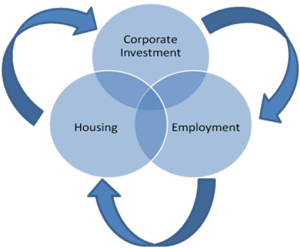By Doug Stephens
Unfortunately, the future isn’t as simple as the headlines might have us believe. It can’t be neatly summed up in the words recession or recovery. Recovery in particular, suggests a return to a previous (and presumably healthier) state, which really isn’t the case here. There is no returning to the way things were. Instead what we face is a fundamental reconstruction; a reconstruction of the American economy, a reconstruction of the American workforce and ultimately a reconstruction of the American competitive advantage. Only once this painful transition is complete is real and sustained prosperity possible.
In particular, there are three interdependent factors that will require correction in order for any meaningful economic reconstruction to take place.
Corporate Investment
If you examine the markets where companies are investing for growth, you’ll quickly get a sense of the emerging global economic order.
Wal-mart for example, whose results have been eerily flat in the United States is investing in and growing at a staggering rate in China. And they’re not alone. Increasingly, North American companies are investing heavily in rapidly developing foreign economies.
Once the incubator for cutting edge concepts in retail marketing and store design, the U.S. is now taking a

back seat to markets like Asia, Russia, India and South America. Instead U.S. retailers are recalibrating for a sustained period of flat to moderate domestic growth. Smaller store concepts in denser, urban markets will steadily become the norm as changes in consumption, population distribution and rising energy costs challenge the profitability of the sprawling suburban power mall model. Service-based businesses, community agencies and other non-traditional tenancies will increase their presence in enclosed regional malls, as America sheds retail square footage in search of equilibrium with demand.
When you take into account that the United States is already over-retailed by anywhere from 25 to 50 percent, it’s going to mean a massive domestic downsizing and redirection of investment into emerging retail markets. So, while profits at places like Wal-Mart might continue to grow, the average American will no longer be the beneficiary. Simply put, America is no longer the cradle of retail innovation or investment.
Employment
As corporations increasingly invest outside the U.S. it can’t help but add to domestic unemployment woes. Furthermore, count on a brain drain of epic proportions as talented American business people follow employment opportunities to emerging nations.
What’s also concerning is the high rate of unemployment among recent college graduates – arguably the consumers of tomorrow – which is projected to worsen as we move through the current decade. The inability to employ our best educated citizens is a real problem.
Even those fortunate enough to have employment will make continued sacrifices as bonuses, increases and benefits are increasingly reined in. The bottom line is that as long as there remains uncertainty around employment and income growth, true and sustained economic recovery is nothing short of impossible.
Housing
Currently, the market in most states continues to search for bottom with the most recent figures pointing to an unexpected average decline of 1.3% in home prices across 20 major markets, according to a S&P/Case-Shiller report, which some analysts even believe might be optimistic. And with unemployment hovering at or near the 10% mark into 2011 home prices will continue to plumb the depths.
Once the market does in fact reach “bottom”, the return to pre-recession values could be protracted. If we assume real estate appreciation at historic norms of around 3 percent per annum, it could be at least 10 years in some markets before prices reach 2005 levels.
For older homeowners who were banking on their equity to fund retirement, this is potentially devastating and will continue to fuel the current saving spree.
Surviving the Reconstruction
So if you’re waiting for a recovery, you could be here a while.
The good news is that the reconstruction is well underway and retailers who understand the difference will survive it.
Yoga and athletic apparel retailer lululemon for example continues to take North America by storm. Nordstrom consistently posts solid results. Apple continues to generate line-ups outside their stores. At the other end of the market, Dollar General continues to impress with outstanding growth.
While being very different companies, they have one important thing in common; a distinct and own-able position in their market. For lululemon it’s a winning combination of quality made clothing and an inspiring corporate culture built around Eastern philosophy. For Nordstrom it’s their unwavering attention to superior service and for Apple it’s brilliantly designed products, backed with a unique store experience. At Dollar General it’s a pursuit of low prices that makes Wal-Mart look like slackers.
These companies and others like them have not allowed fear of the recession to distract them from what makes them strong. They haven’t let it water down their brand propositions. They don’t try to be things that that they’re not. They know who they are.
Winning retailers like these understand that they can no longer count on a rising tide of economic prosperity to lift their ship. Those days are gone. Instead, they have to invent a market where no market exists and steal market share where it does.
They know there’s no longer a free pass to the future. In fact the price of admission is steep. Getting through the doors of the future means being coveted, loved and above all, being remarkable.

